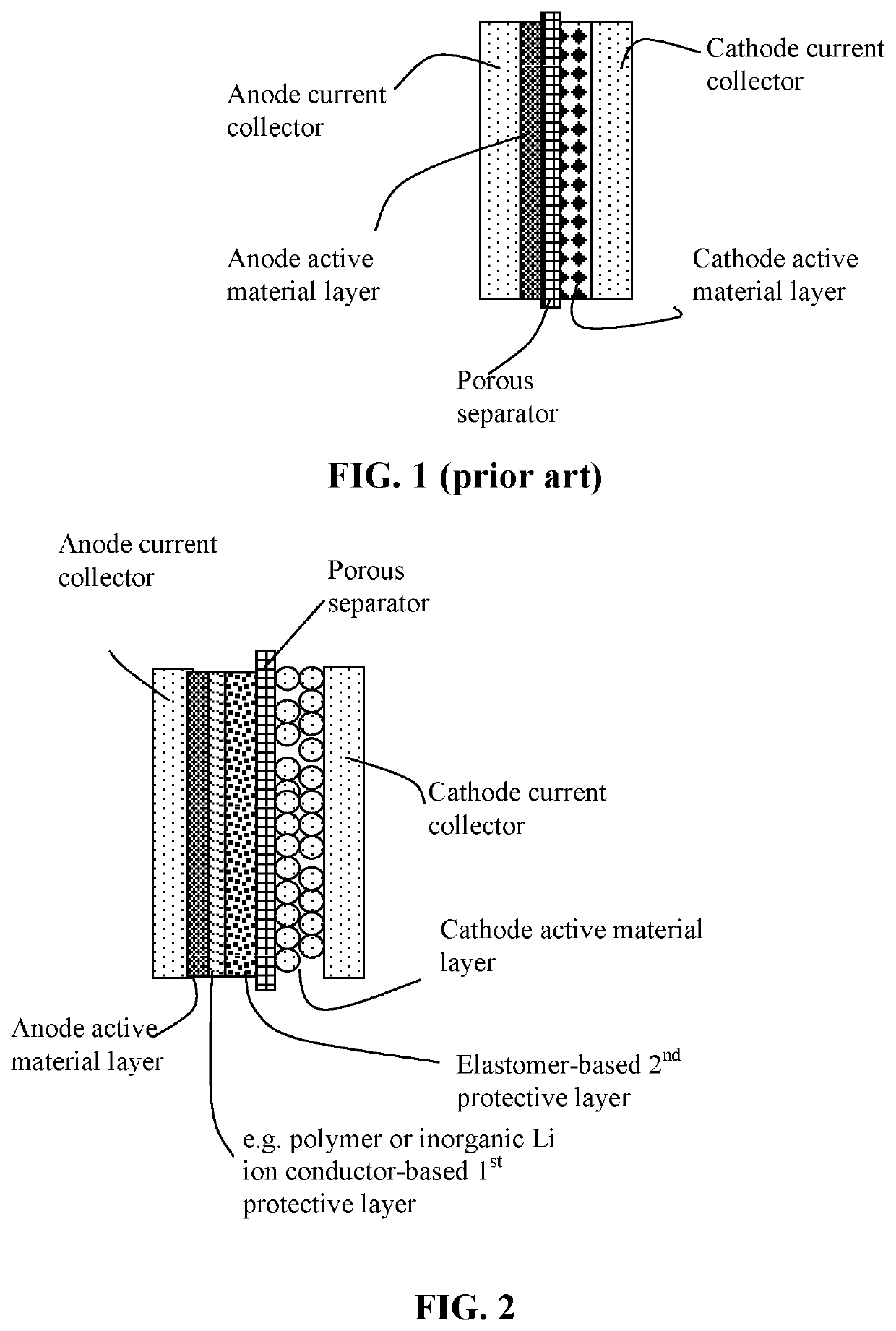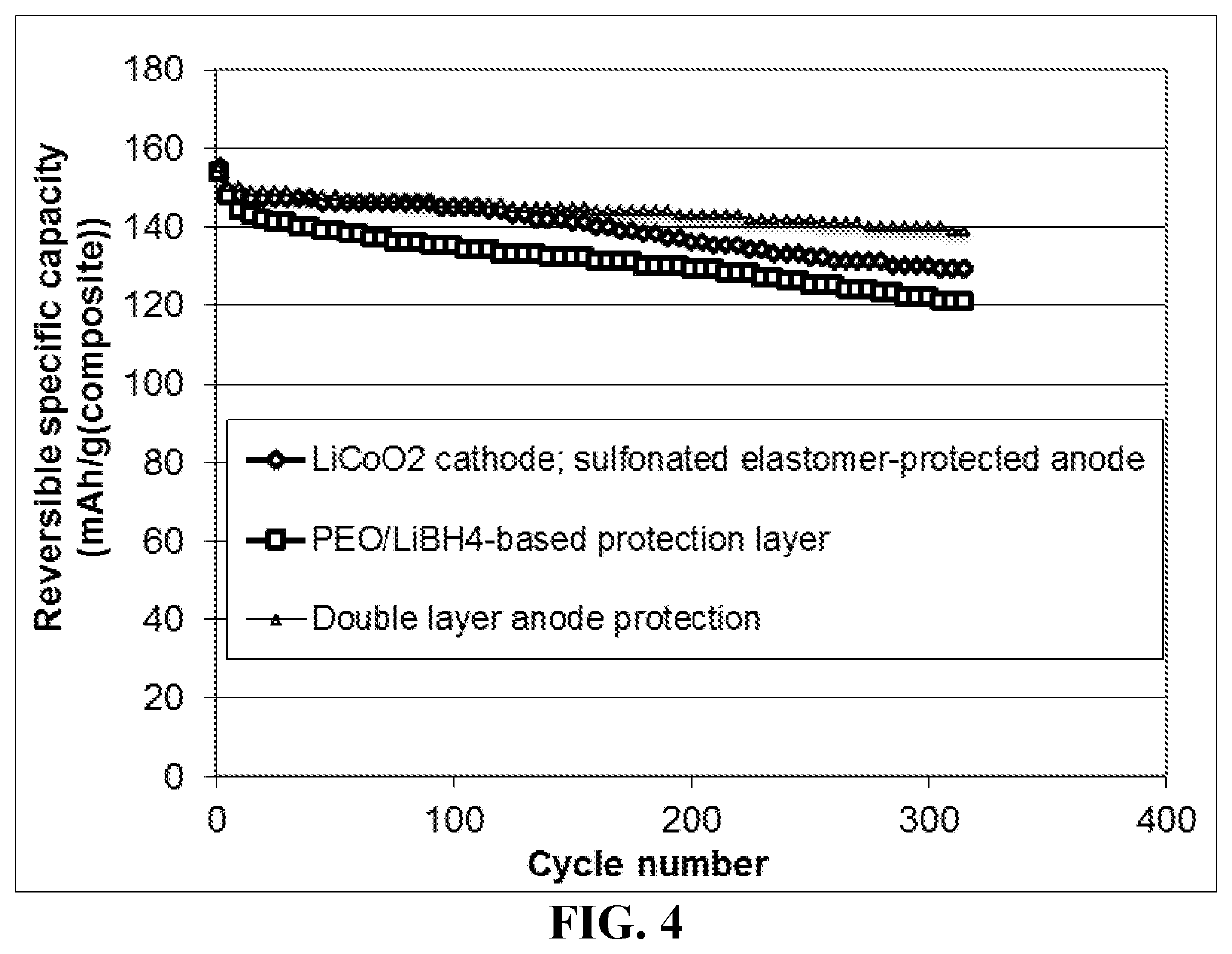Lithium metal secondary battery containing a protected lithium anode
a lithium anode and secondary battery technology, applied in the direction of cell components, final product manufacturing, sustainable manufacturing/processing, etc., can solve the problems of internal electrical shorting and thermal runaway, unsafe conditions in the battery, and further commercialization, so as to reduce or eliminate the lithium metal dendrite and facilitate the uniform deposition of li metal
- Summary
- Abstract
- Description
- Claims
- Application Information
AI Technical Summary
Benefits of technology
Problems solved by technology
Method used
Image
Examples
example 2
f Lithium Ion-Conducting Polymer as a First Anode-Protecting Layer
[0136]Poly [(oxyethylene)9 methacrylate]-g-poly(dimethyl siloxane) (POEM-g-PDMS) (70:30) was synthesized by free radical methods. In one representative procedure, 6 mL of poly(dimethyl siloxane) monomethacrylate macromonomer (Aldrich, Mn=10,000 g / mol) and 13 mL of poly(ethylene glycol) methyl ether methacrylate monomer (Aldrich, Mn=475 g / mol) were added to 80 mL of ethyl acetate under a constant-stirring condition. This formulation corresponds to a weight ratio of 70:30 (POEM:PDMS) or a molar ratio of ˜50:1 (POEM:PDMS side chains). Subsequently, 6 mg of the initiator 2,2-azobisisobutyronitrile (AIBN, Aldrich) were added (monomer / initiator ratio==825 / 1) and the flask was sealed and purged for 30 min with argon. The solution was then heated to 68° C. in an oil bath and left under constant stirring. After 24 h, the polymer was precipitated in hexane and cast into films. The product had a molecular weight of ˜480,000 g / mo...
example 5
on of Perovskite-Type Oxynitride Solid Solutions
[0140]Precursor material, Li0.5La0.5TiO3, was prepared by a conventional solid-state reaction technique. Reagents of Li2CO3 (Alfa 99.9% in purity), La2O3(Alfa 99.9% purity, heated overnight at 1000° C. in air atmosphere) and TiO2 (Sigma Aldrich 99.9% purity) were mixed in a molar ratio of 1.1:1:2. Considering the potential loss of Li during the evaporation, 10% excess was used to obtain the desired composition. The mixture was annealed at 1073° K for 6 hours and subsequently at 1473° K for 12 hours in air atmosphere with several intermittent grindings until single phase Li0.5La0.5TiO3 was obtained.
[0141]Polycrystalline oxynitride powder samples were prepared by thermal ammonolysis of synthesized precursor Li0.5La0.5TiO3 with flowing ammonia (500 ml / min) for 1, 5 and 10 hours at 1223° K. In addition to the conventional solid-state reaction technique, polycrystalline oxynitride powder samples were also obtained by thermal ammonolysis of ...
example 6
on of Triblock Copolymer Poly(Styrene-Isobutylene-Styrene) or SIBS
[0142]Both non-sulfonated and sulfonated elastomers are used to build the second anode-protecting layer in the present invention. The sulfonated versions typically provide a much higher lithium ion conductivity and, hence, enable higher-rate capability or higher power density. The elastomer matrix can contain a lithium ion-conducting additive, an electron-conducting additive, and / or a lithium metal-stabilizing additive.
[0143]An example of the sulfonation procedure used in this study for making a sulfonated elastomer is summarized as follows: a 10% (w / v) solution of SIBS (50 g) and a desired amount of graphene oxide sheets (0 to 40.5% by wt.) in methylene chloride (500 ml) was prepared. The solution was stirred and refluxed at approximately 40° C., while a specified amount of acetyl sulfate in methylene chloride was slowly added to begin the sulfonation reaction. Acetyl sulfate in methylene chloride was prepared prior ...
PUM
| Property | Measurement | Unit |
|---|---|---|
| lithium ion conductivity | aaaaa | aaaaa |
| thickness | aaaaa | aaaaa |
| lithium ion conductivity | aaaaa | aaaaa |
Abstract
Description
Claims
Application Information
 Login to View More
Login to View More - R&D
- Intellectual Property
- Life Sciences
- Materials
- Tech Scout
- Unparalleled Data Quality
- Higher Quality Content
- 60% Fewer Hallucinations
Browse by: Latest US Patents, China's latest patents, Technical Efficacy Thesaurus, Application Domain, Technology Topic, Popular Technical Reports.
© 2025 PatSnap. All rights reserved.Legal|Privacy policy|Modern Slavery Act Transparency Statement|Sitemap|About US| Contact US: help@patsnap.com



